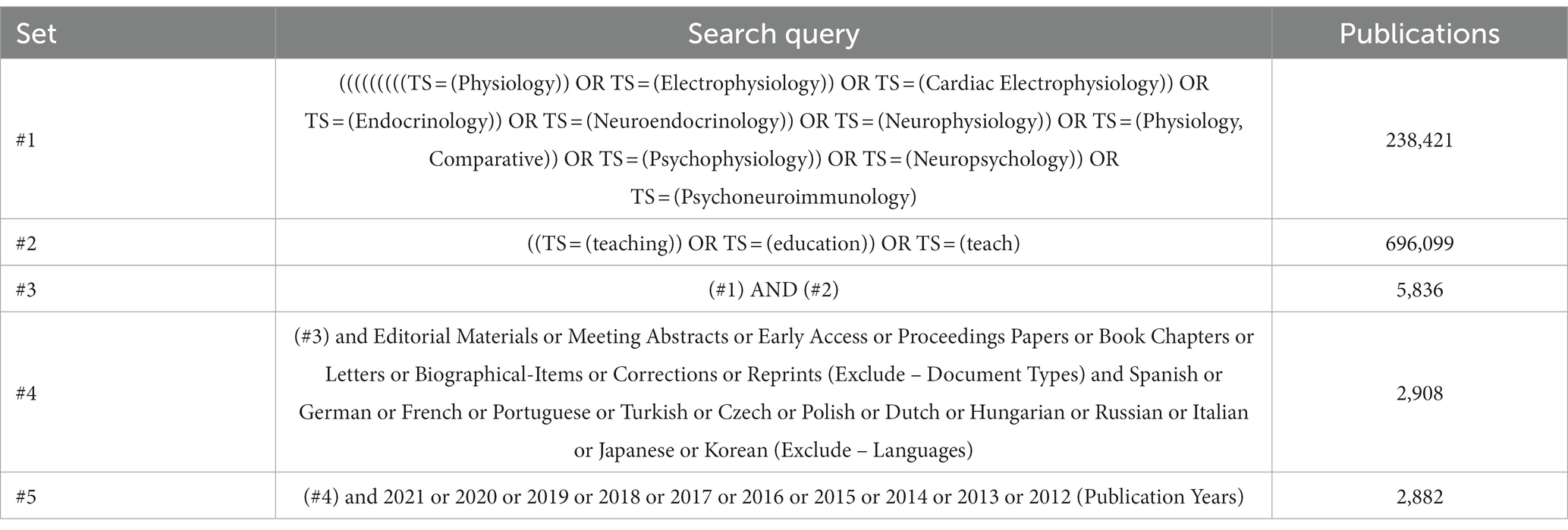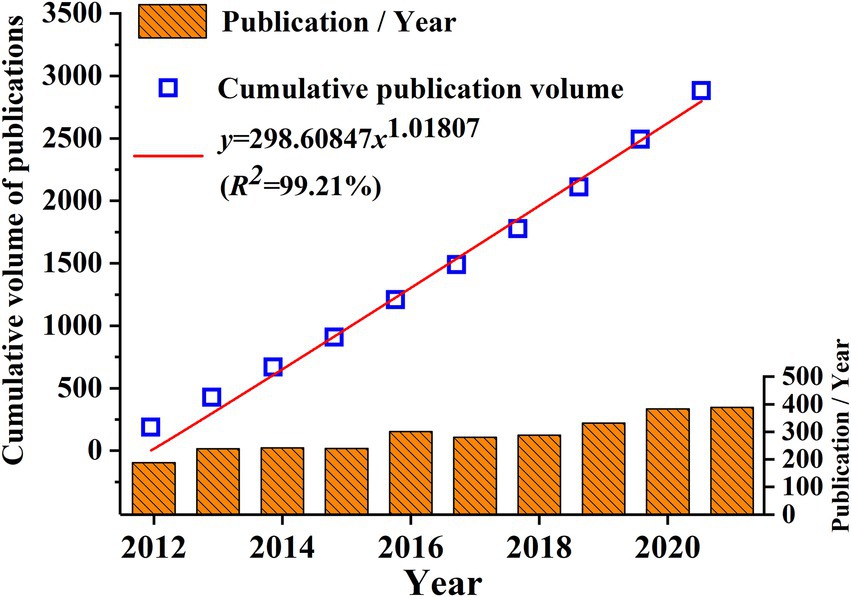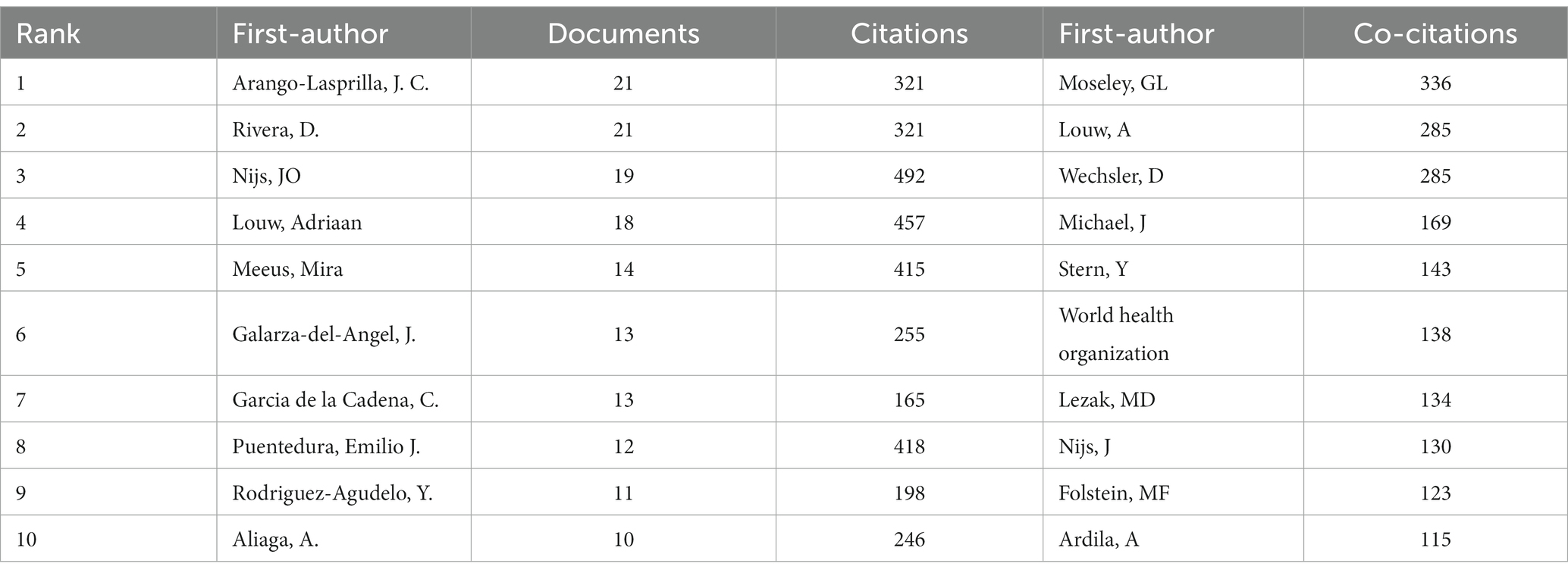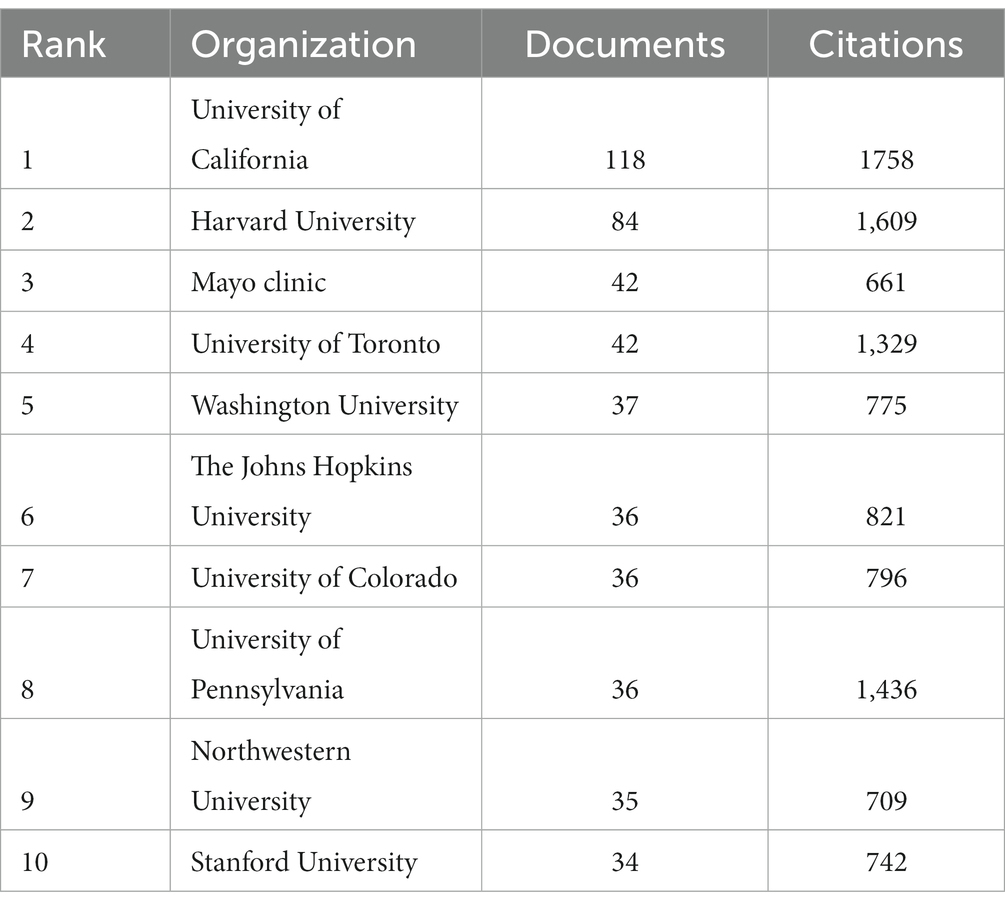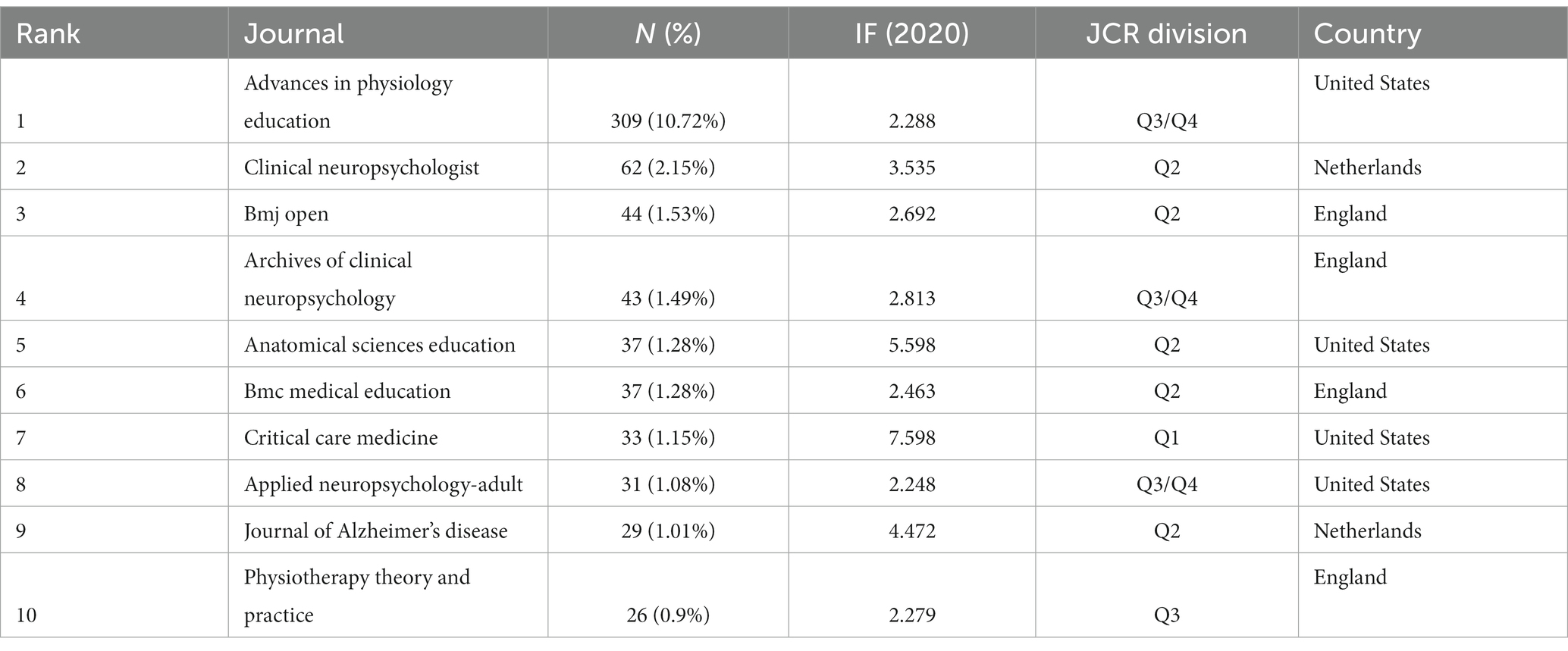- 1Department of Physiology and Pharmacology, NBU Health Science Center, Ningbo University, Ningbo, Zhejiang, China
- 2The First Affiliated Hospital of Ningbo University, Ningbo, Zhejiang, China
Objective: To identify author collaborations and impact; participating countries, institutions, and journals; evaluate the knowledge base; and analyze research hotspots and frontiers in teaching reforms in physiology.
Methods: Articles and reviews related to teaching reforms in physiology published between January 1, 2012, and December 31, 2021, were obtained from the Web of Science Core Collection. Two Scientometric software applications (CiteSpace 5.7 and VOSviewer 1.6.15) were used to perform bibliometric and knowledge-map analysis, generate network maps, and identify research trends and top keywords, authors, co-cited authors, institutions, countries, journals, and references.
Results: The search identified a total of 2,882 papers in 466 academic journals by 13,895 authors from 4,072 organizations in 67 countries/regions. Physiology teaching reform-related publications increased rapidly over time. Arango-Lasprilla and Rivera published the most papers, while Moseley had the most co-citations. Active collaborations among physiology researchers were noted. Advances in Physiology Education published the most papers on physiology teaching reforms and was also the top co-cited journal in the Medicine/Medical/Clinical, Psychology/Education/Health, and Neurology/Sports/Ophthalmology fields. The United States and University of California published the most physiology teaching publications in the search criteria. Ten references (research articles and reviews) on mechanisms and diseases were identified as the knowledge base. The mainstream research directions were education, Alzheimer’s disease, performance, physiology, and risk factors. Mental health and emotion regulation are increasing in significance and may become new hotspots. The research trend to move from the field of pain pathogenesis to the field of neuropsychiatry has become increasingly clear. This tendency away from peripheral system-based disorders to central system-based orders is inextricably linked to further developments in physiological understanding of the brain.
Conclusion: This study analyzed the research hot spots and frontiers of teaching reforms on in physiology using bibliometric and visual methods. Based on the results, rehabilitation, neurosciences, and infectious disease are hot topics in physiology. In particular, the pathogenesis of neurological diseases, treatment strategies, and technology updates have gradually become research hotspots. We predict that this trend is closely related to the implementation of brain research programs in various countries. These findings provide helpful references for scholars focusing on physiology education.
Introduction
Physiology is the study of the body and its functional activities (1). Physiology also explores the intrinsic relationship between such activities and the occurrence, development, and treatment of diseases, and is thus a cornerstone for clinical medicine and research as well as an important bridge between basic and clinical disciplines (2). The Nobel Prize in physiology and medicine (3–5) is considered the most prestigious in the world and reflects the importance of this topic. Accordingly, physiology is a compulsory subject for undergraduate medical majors and for the National Professional Licensing Examination and the National Master’s Examination in General Western Medicine in China (6, 7). In the modern era, medical education faces new tasks and challenges as medical technology develops. To promote medical education and train many high-quality medical talents, medical teaching reform is a top priority.
Over the decades, physiology research has developed a certain scale and character. There is no shortage of macroscopic descriptions of physiology research, most of which are based on specific perspectives. Several studies have explored specific areas of physiology education. To assess teaching methods, Li et al. highlighted the importance of clinical knowledge and experience on reform of teaching preclinical pathophysiology (8). Emery et al. sought to examine the relative importance of environmental influences and individual characteristics on learner-centered teaching practices across institutions (9). Semsar et al. described the development of a new, freely available, online, programmatic-level assessment tool termed Measuring Achievement and Progress in Science in Physiology (Phys-MAPS) to evaluate student learning of core physiology concepts at multiple time points during an undergraduate physiology program, thus providing a valuable longitudinal tool to gain insight into student thinking and aid data-driven reform of physiology curricula (10). Sherer et al. focused on integrating histology and physiology into one course, increasing the two subjects’ connection to clinical medicine, and assessing support for integration and state-of-the-art teaching by comparing students’ attitudes and academic performance in the reformed curriculum (11). To assess teaching content, Ma et al. visualized research hotspots and trends in pyroptosis using bibliometric analysis to understand future developments in basic and clinical research (12). Wang et al. used the bibliometric method to focus on the mechanisms of oxidative stress, neuroinflammation, and autophagy in Parkinson’s disease using animal models (13). Wang et al. summarized the research status of butyrophilins (BTNs), a unique family of immunoglobulins, and their relationship with lung and breast cancers using bibliometrics and bioinformatics methods (14).
The evolution of sub-disciplines and specific research directions in physiology is becoming clearer due to the rapid development of information technology and bibliometrics. However, hot spots and research frontiers in this field are still unclear. Specifically, there is a lack of research on physiology teaching reform (The abbreviation is unified as PTR in this study.). Scientometrics is a branch of informatics that quantitatively analyzes patterns in scientific literature in order to understand emerging trends and the knowledge structure of a research field. Science mapping tools typically use scientific publications as input and generate interactive visual representations of complex structures for statistical analysis and visual exploration (15, 16). CiteSpace is a Java-based application to analyze and visualize hot spots and research frontiers in the scientific literature of a discipline or knowledge domain over a certain period using metrology, co-occurrence analysis, and cluster analysis (15, 17, 18). VOSviewer is software for creating, visualizing, and exploring maps based on web data (19). In addition, it can be used to identify productive journals, co-cited journals, authors, co-cited authors, and related knowledge graphs based on bibliographic data. In the present study, we aimed to analyze hot spots and research frontiers in physiology teaching reform (PTR) using CiteSpace and VOSviewer. We hope the findings will help us understand the future development of basic teaching and clinical research.
Materials and methods
Data collection
Data were retrieved from the Web of Science Core Collection (WoSCC) database on May 22, 2022. The WoSCC database covers resources dealing with various branches of science and is regarded as the most influential database1. “Physiology” and “Teaching and learning reform” were set as the search terms for articles published between January 1, 2012, and December 31, 2021. The language was restricted to English and the article type was limited to article or review. Table 1 shows the detailed search strategy, including the inclusion and exclusion criteria.
Bibliometrics and visualization analysis
The “full record and cited references” for the articles identified through the search were exported in “plain text” or “tab delimited” format, named “download_XXX.txt,” and then imported into VOSViewer 1.6.18 and/or CiteSpace 6.1.R2 for further analysis.
We used CiteSpace 6.1.R2 to analyze and visualize trends of high-frequency keywords, dual-map of journals, co-cited references, and citation bursts for references (20, 21). Data analysis was followed by time slicing, thresholding, modeling, pruning, merging, and mapping. The selection criteria of CiteSpace uses a modified g-index per slice (1 year per slice from January 2012 to December 2021). To include more or fewer nodes, we set the scale factor as k = 25, the filter criteria as pruning (minimum spanning tree, pruning sliced networks, and the merged network), and the selection criteria (top N = 50). For all other settings, the defaults were used (22).
Similarly, we used VOSviewer to identify productive journals, co-cited journals, authors, co-cited authors, and the related knowledge-maps based on bibliographic data. After data cleaning, synonym merging, and deletion of meaningless terms, the high relevance score tendencies in terms of analysis of co-author and keywords were calculated by the fractional counting method (23, 24) The thresholds (T) of authors and countries/regions and organization were set as 5 (25), which are marked in the corresponding tables and figures.
Moreover, we used Microsoft Office Excel 2019 and Origin 2018 to manage the database and fit the analysis. We obtained the 2019 impact factor (IF) and JCR division of journals from the Web of Science InCites Journal Citation Reports2 on October 25, 2021.
Results
Annual growth trends and distribution of articles
By applying the data collection strategy described above, we obtained 2,882 papers with a total of 128,732 references; this does not include any duplicates. The collected papers were imported into CiteSpace and filtered to identify 2,568 as unique source articles in WOS. The annual growth trend and distribution of the articles was then analyzed. As shown in Figure 1, PTR-related articles showed an annual upward tendency with some fluctuations per year. A descriptive fitting analysis was performed on the cumulative annual volume of publications from 2012 to 2021. The rapidly increasing trend conforms to the formula: y = 298.60847x1.01807 (R2 = 99.21%). The yearly output of related publications increased the most significantly (by over 300 publications) from 2019 to 2021, indicating that more and more researchers are beginning to pay attention to this field.
Co-authorship and co-cited authors
For the co-authorship results, a total of 13,895 authors were involved in PTR. Of these, 70 authors published more than 5 articles (T ≥ 5), which were included to build a network map of authors (Figure 2). The co-authors (n = 29) of the 70 authors with 5 published articles were used to make an overlay visualization map; this type of knowledge-map can clearly present high-frequency co-authors by year. The size of the node reflects the author’s co-occurrence frequencies, while the link indicates the co-occurrence relationship between authors. For each of the 70 authors, the total strength of the co-authorship links with other authors was calculated. Arango-Lasprilla, JC. and Rivera, D. both published the most papers (n = 21), followed by Nijs, J (n = 19), Louw, A (n = 18), and Meeus, A (n = 14) (Table 2). Co-cited authors are authors who have been co-cited together in a range of publications. A total of 76,781 co-cited authors were involved in this research area. Of these, 215 co-cited authors published over 20 articles (T ≥ 20). Moseley, GL (n = 336) ranked first, followed by Louw, A (n = 285), Wechsler, D (n = 285), Michael, J (n = 169), and Stern, Y (n = 143). The remaining five top authors had 138 to 115 co-citations (Table 2).
Co-institution and co-country
A total of 4,072 organizations were involved in PTR publishing. Of these, 328 organizations published more than five articles (T ≥ 5). These were included to build a network density map of countries (Figure 3A). The size of the word, the size of circles, and the opacity of yellow are positively related to the co-occurrence frequency. For each of the 328 countries, the total strength of the co-authorship links as calculated. University of California published the most papers (n = 118), followed by Harvard University (n = 84), Mayo Clinic, University of Toronto (n = 42), Johns Hopkins University, University of Colorado, and University of Pennsylvania (n = 36, Table 3). A total of 120 countries were involved in PTR research, of which 67 countries published more than five articles (T ≥ 5). These were used to build a network map of country, and different colors are used to distinguish national clusters (Figure 3B). For each of the 67 countries, the total strength of the co-authorship links was calculated. The United States published the most papers (n = 1,266) followed by England (n = 237), Australia (n = 226), Canada (n = 212), Spain (n = 150), and China (n = 139).
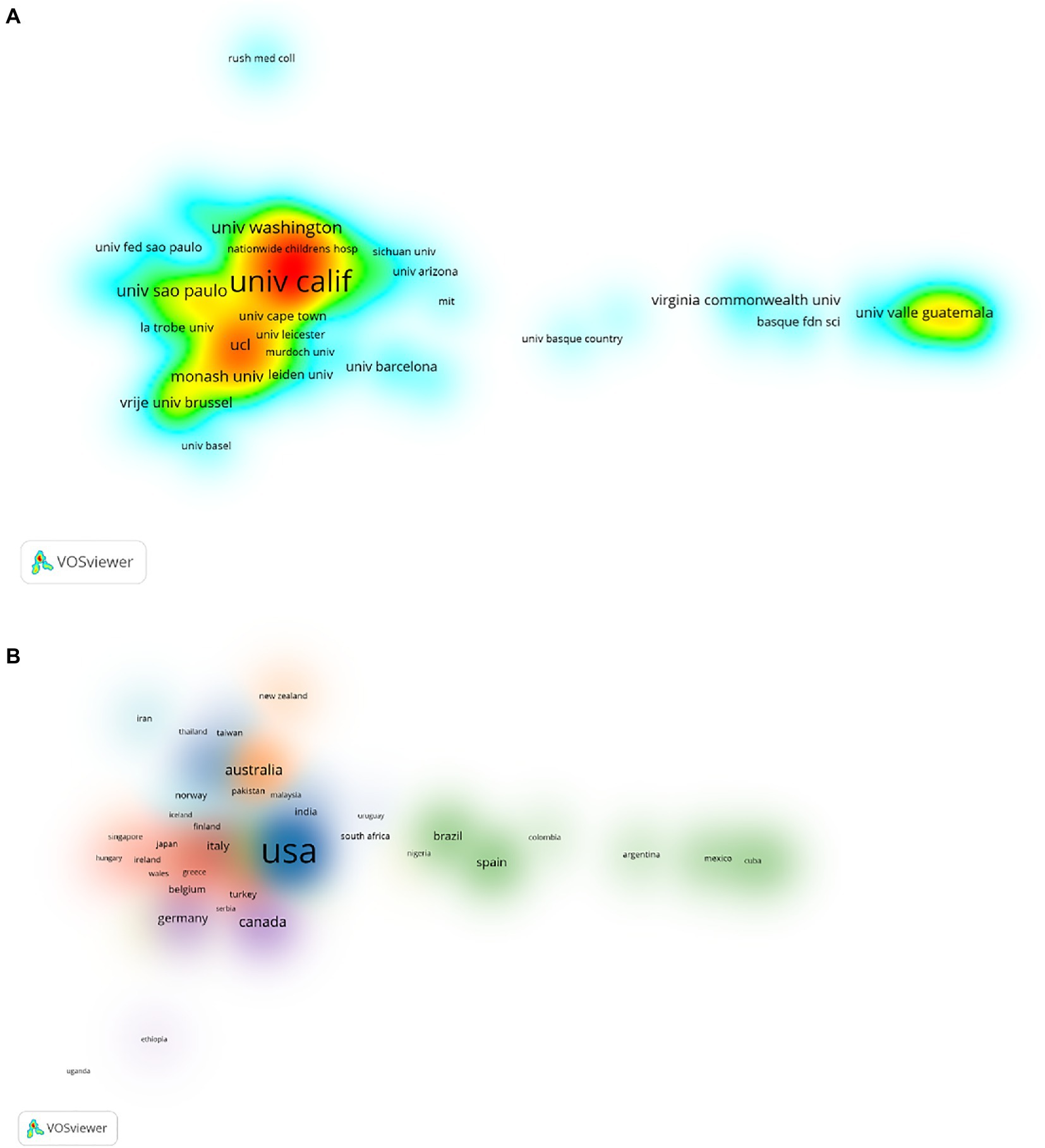
Figure 3. The density map of co-organizations (A). The density map of co-country in Physiology teaching reforms (B).
Keyword co-occurrence, clusters, and evolution
Keywords provide a high-level summary of articles. High frequency and high centrality keywords often reflect hot research topics in a field. The 2,568 unique records identified in WOS were analyzed using CiteSpace. We analyzed publications with a time slicing of 1 year and the top 20 levels of most cited or occurring items from each slice (Figure 4). The trajectory of relevant research is shown as a hybrid network of keyword co-occurrence from the titles and abstracts. Nodes in different maps represent keywords. The size of the nodes indicates the frequency of occurrence or citation, while the color of nodes indicates the occurrence or citation years. Red circles indicate articles with keyword bursts, i.e., rapid increases in publication count. By analyzing the frequency and centrality of keywords, research frontiers can be identified. The network map of keywords consists of 439 nodes and 1,693 links. “Education” has a high frequency and centrality, which means that reform of physiology teaching focuses on students’ practical performance in terms of educational performance and effectiveness (Figure 4A). Similarity, the terms “Alzheimer’s disease” and “performance” are high frequency keywords, reflecting that physiological research about Alzheimer’s disease is a hot topic in current research.
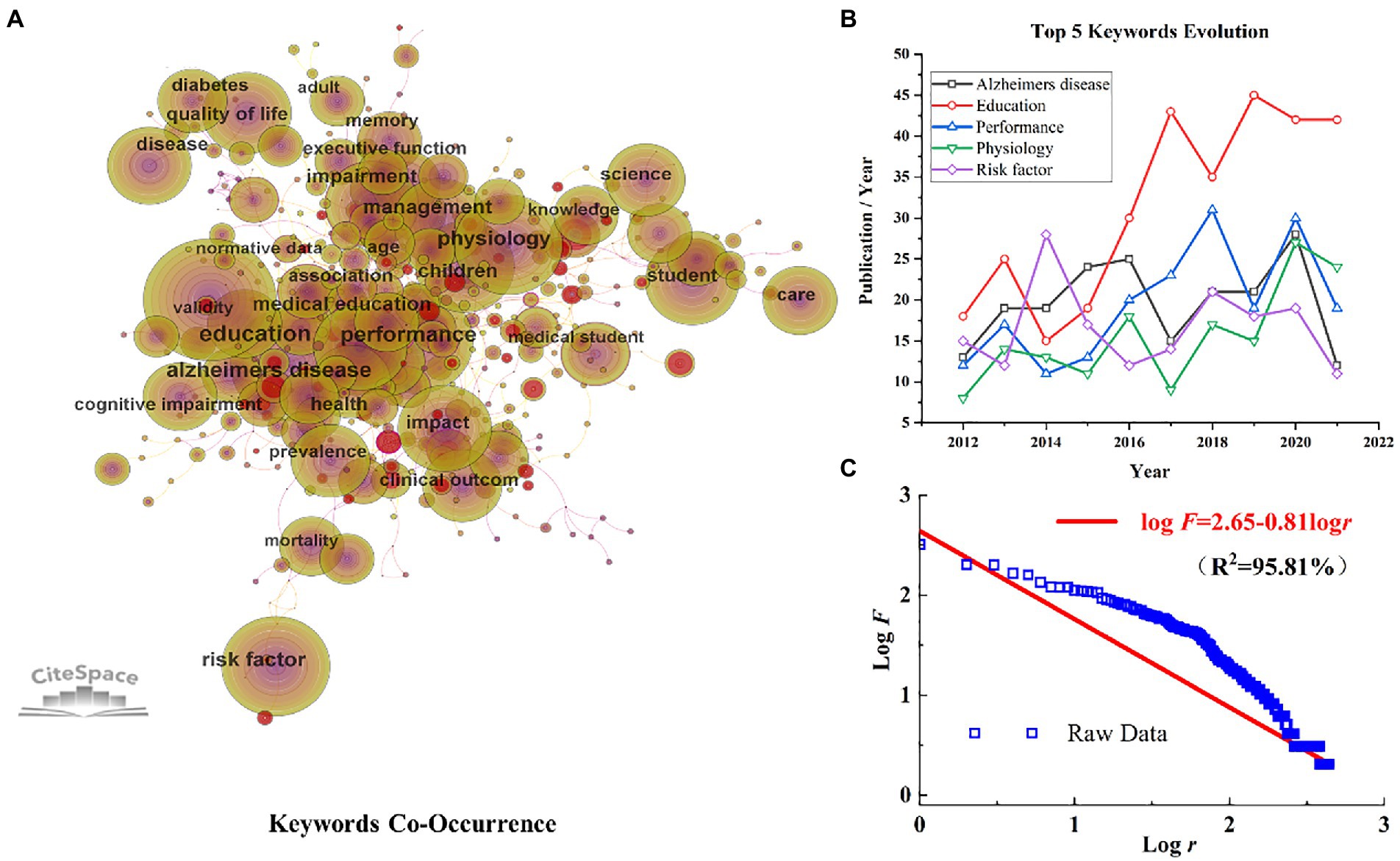
Figure 4. (A) The network of keywords co-occurrence. (B) The evolution of Top 5 keywords. (C) Zipf’s law data fitting of key words in physiology teaching reform.
The annual evolution of the top five hot topics with a trend of floating growth is displayed in Figure 4B. The data were quantified and fitted to derive a clearer picture of the evolutionary pattern of the topical vocabulary in physiological research (Figure 4C). The increasing trend in physiological research obeys Zipf’s Law ( , R2 = 95.81%), which is an empirical law of great ubiquity. The top 20 keywords with a high frequency and centrality are presented in Table 4. Interestingly, the term “damage” has a higher centrality which is presumably closely related to the pathological manifestation of brain damage in Alzheimer’s disease.
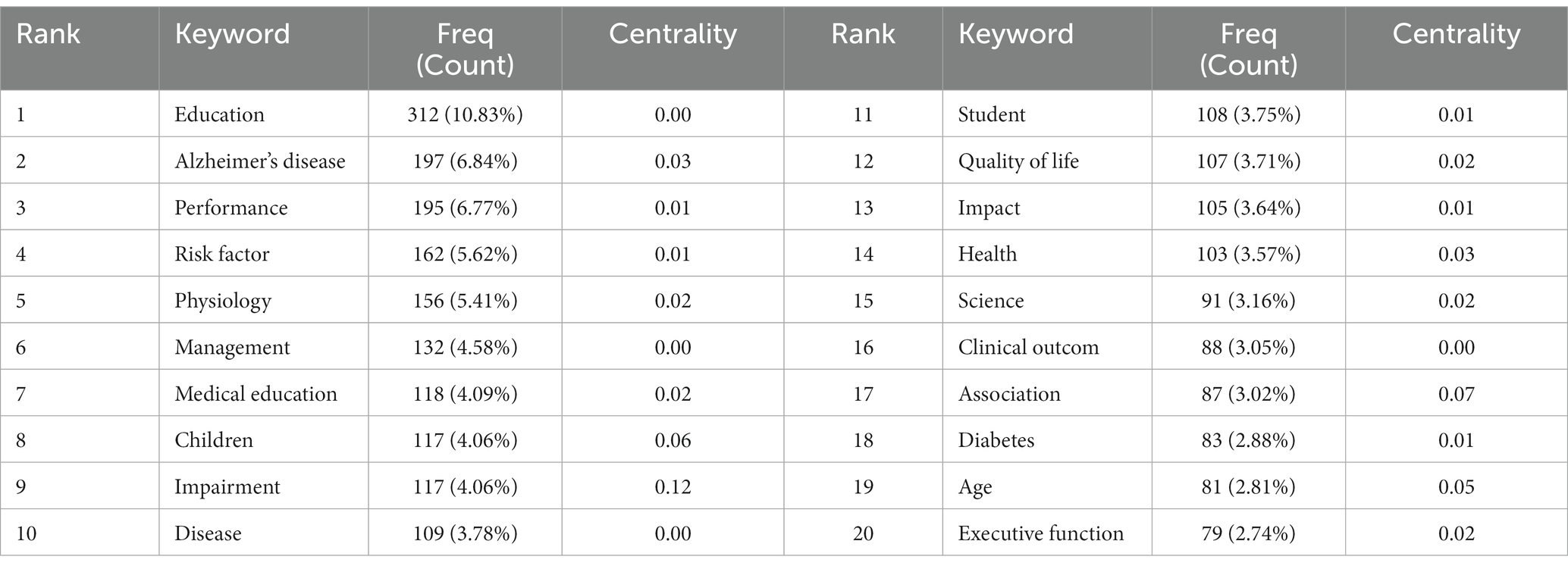
Table 4. Top 20 keywords of physiology teaching reform research in terms of frequency and centrality.
Cluster analysis can reveal the knowledge structure of a research field (26). To identify the disciplines to which the hot topics belong, we performed a subject clustering analysis of the keywords after simplification by Pathfinder network scaling. According to the link strength of term co-occurrence, the network was divided into 11 clusters (Figure 5). It is highly homogeneous and the most salient connections are between the terms in one cluster. Each article indexed by the Web of Science is assigned one or more subject categories. The most common category is Education (Scientific disciplines), which is also the largest cluster with 34 co-occurrence terms: assessment tool, academic stress, academic achievement, Blooms Taxonomy, Angiography, etc. Cluster 0 is followed by Rehabilitation (Cluster 1), Neurosciences (Cluster 2), and Infectious Disease (Cluster 3). Cluster 1 (Red-orange) includes 30 terms: Boston Naming Test, Motor, Physiotherapy Student, Head Injury, Physiotherapy, etc. Cluster 2 (orange) contains 28 terms: Alzheimer’s Disease, Mild Cognitive Impairment, Life, etc. Cluster 3 (yellow) has 27 terms: Epidemiology, Prevention, Risk Factor, etc. Although Physiology, Endocrinology & Metabolism, Critical Care Medicine, Respiratory System, Reproductive Biology, Psychology, and Clinical Neurology are much smaller clusters, they are marked for reference. The sub-disciplines around physiology remain an important part of the exploration of PTR.
The keyword time zone view was designed by CiteSpace to clearly show the evolution of high frequency keywords. Keywords are located in the year they first co-occurred and the color of the links represents the first year two keywords appear simultaneously. Consequently, we added the top 10 high frequency keywords each year from 2012 to 2021 to supplement the time zone map (Figure 6). The size of the cross and word reflects the co-occurrence frequencies, while the link indicates the co-occurrence relationship. The colors of the node and line represent different years; colors vary from purple to red as the years go from 2012 to 2021. Of these, Clinical Neuropsychology may have experienced a turning point with a high count in 2016.
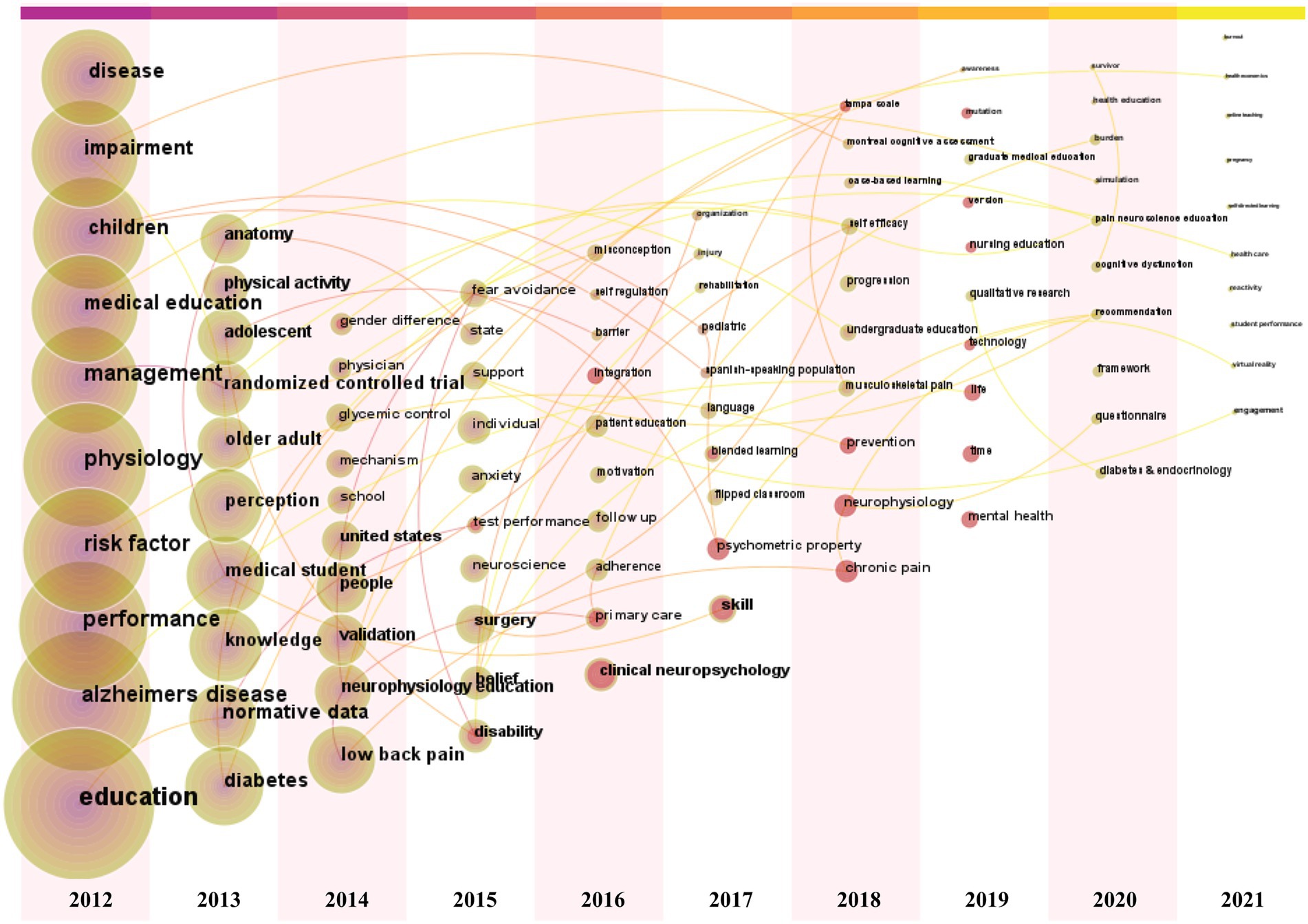
Figure 6. The annual top 10 keywords of physiology teaching reforms were showed by keywords time zone view in 2012–2021.
The keyword clusters were also displayed in the keyword timeline view (Figure 7A). The six keyword clusters included Neuropsychology, Low Back Pain, Alzheimer’s Disease, Mortality, Executive Function, and Thyroxine Treatment. The keywords with citation bursts appeared in 2012, 2013, 2016, 2019, and 2021. The top 20 keywords with citation bursts are presented in Figure 7B. The blue line indicates the time interval, while the red line indicates the time period when the keyword had a burst (17). The keywords Intensive Care Unit had the strongest citation burst and appeared in 2012, indicating the importance of medical facilities in physiological research. The most recent keywords with citation bursts that occurred in 2019 were Mental Health and Emotion Regulation, demonstrating the focus on mental and neurological health in recent years.
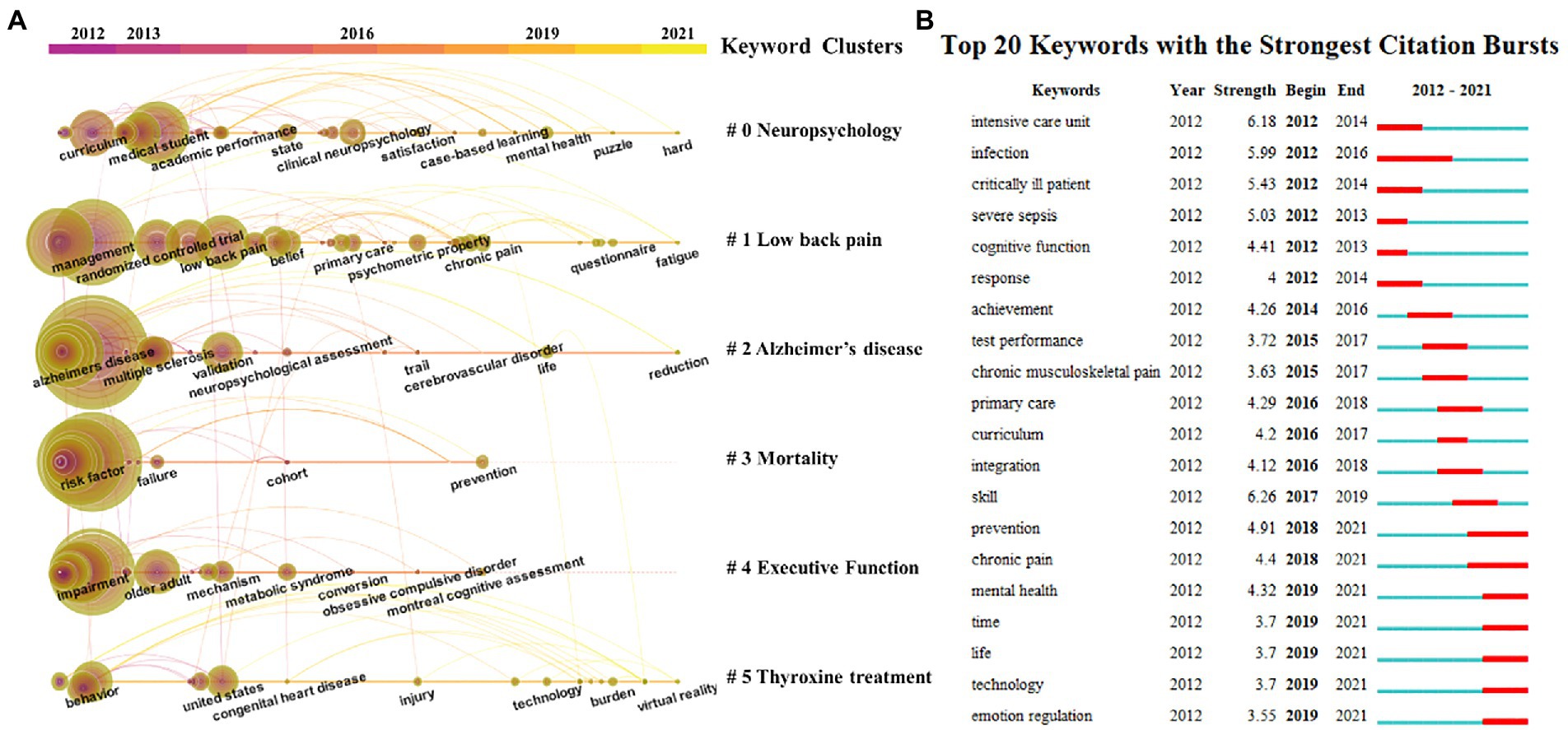
Figure 7. (A) The keywords of physiology teaching reforms were showed in keywords timeline view in 2012–2021. (B) The top 20 keywords with citation bursts.
Journals and co-cited journals
We used VOSviewer to conduct co-citation and co-cited journal analyses, finding the most active and influential journals in the field. The results described that the 1,267 references were published in 466 academic journals. Advances in Physiology Education published the most papers (309, 10.72%), followed by Clinical Neuropsychologist, BMJ Open, Archives of Clinical Neuropsychology, Anatomical Sciences Education, BMC Medical Education, Critical Care Medicine, Applied Neuropsychology-Adult, Journal of Alzheimer’s Disease, and Physiotherapy Theory and Practice. Among the top 10 journals, “Critical Care Medicine” was in the Q1 JCR division, five were in the Q2 JCR division, and two had an impact factor (IF) greater than five (Table 5).
Among the 4,781 co-cited journals, two journals had more than 1,000 citations. As shown in Supplementary Table S1, Advances in Physiology Education had the most co-citations (2,177, 75.54%) followed by Critical Care Medicine and Clinical Neurophysiology. Among the top 10 co-cited journals, four were in the Q1 JCR division with an IF greater than seven and five were from the United States. The dual-map overlay of journals reflects the topic distribution of academic journals (18) (Figure 8). The three primary citation paths colored green were identified, meaning that studies published in Psychology/Education/Social journals, Health/Nursing/Medicine journals, and Molecular/Biology/Genetics journals were mainly cited by studies published in Medicine/Medical/Clinical journals. Three primary citation paths colored blue were identified, meaning that studies published in Molecular/Biology/Genetics journals, Health/Nursing/Medicine journals, and Psychology/ Education/Social journals were mainly cited by studies published in Psychology/Education/Health journals. One primary citation path colored pink was identified, which means that the studies published in Psychology/Education/Social journals were mainly cited by studies published in Neurology/Sports/Ophthalmology journals.
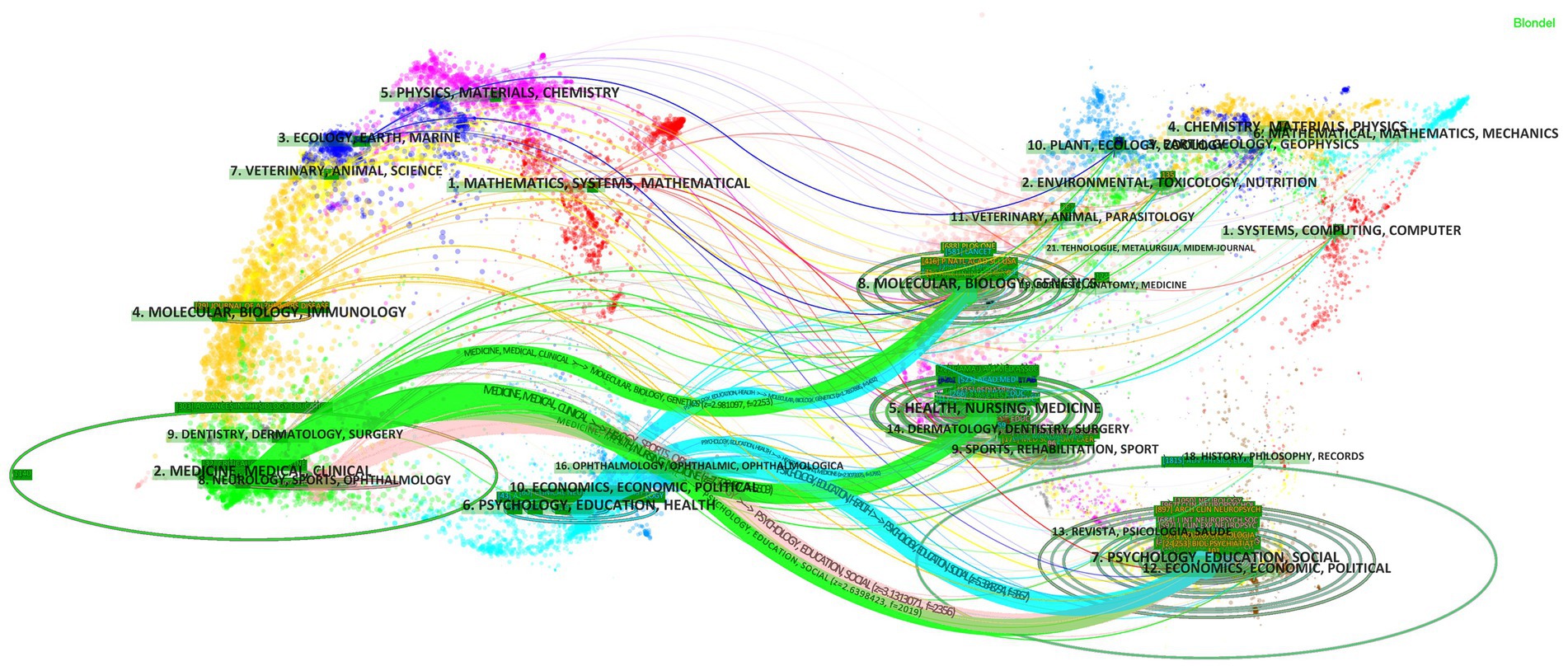
Figure 8. The dual-map overlay of journals related to physiology teaching reform research. The citing journals were at left, the cited journals were on the right, and the colored path represents citation relationship.
Reference co-citations
We used CiteSpace to examine co-cited references. Figure 9 and Supplementary Table S2 show the top 10 co-cited references with a high frequency and betweenness centrality. The network of co-cited references in PTR research comprised 65,889 references with 495 nodes and 833 links. The top co-cited reference was an article published in Arch Phys Med Rehab by Louw et al. entitled “The effect of neuroscience education on pain, disability, anxiety, and stress in chronic musculoskeletal pain.” The article reports the effectiveness of neuroscience education for pain, disability, anxiety, and stress in chronic musculoskeletal pain (27). Many studies examined pain. The reference published by Moseley et al. introduced the concept of explaining pain (EP) to help patients understand current thought in pain biology (28). Freeman et al. demonstrated that lecturing maximizes learning and course performance through a meta-analysis of 225 studies of student performance in undergraduate science, technology, engineering, and mathematics (STEM) courses under traditional lecturing versus active learning (29). Van et al. examined whether education about the neurophysiology of pain is accompanied by changes in symptoms, daily functioning, pain beliefs, and behavior in a single-case study (30). Louw et al. noted that the addition of neuroscience education to usual preoperative education results in superior outcomes with regard to pain, function, surgical experience, and health care utilization post-surgery (31, 32). Arango-Lasprilla et al. analyzed the characteristics of individuals working in neuropsychology in Latin America to forge links between neuropsychology and personal background and performance (33). Other highly cited publications were as follows: Nijs et al. revealed that pain physiology education can be accomplished by patient education about central sensitization and its role in chronic pain (34). Colleary et al. considered the effect of pain neurophysiology education (PNE) on student physiotherapists (35). Olabarrieta-Landa et al. pointed out that neuropsychology in Spain needs to regulate professional neuropsychology, improve graduate curricula, enhance existing clinical training, develop professional certification programs, validate and create normative data for existing neuropsychological tests, and create new, culturally relevant instruments (36).
Figure 10 presents the top 26 references with strongest citation bursts, which indicate emerging trends or increasing interests in the field. Generally, the most co-cited references have the strongest citation bursts. The strongest citation bursts ranking showed that 23.08% (6/26) of references had citation bursts in 2018, followed by 2015 (5/26, 19.23%) and 2013 (4/26, 15.38%). Notably, three references (11.54%) had bursts until 2020. The paper with the strongest burstness (strength = 6.01) was entitled “The effect of neuroscience education on pain, disability, anxiety, and stress in chronic musculoskeletal pain” (27), which also was the most co-cited reference published in Arch Phys Med Rehabil by Louw et al. in 2011 with a citation burst from 2013 to 2016.
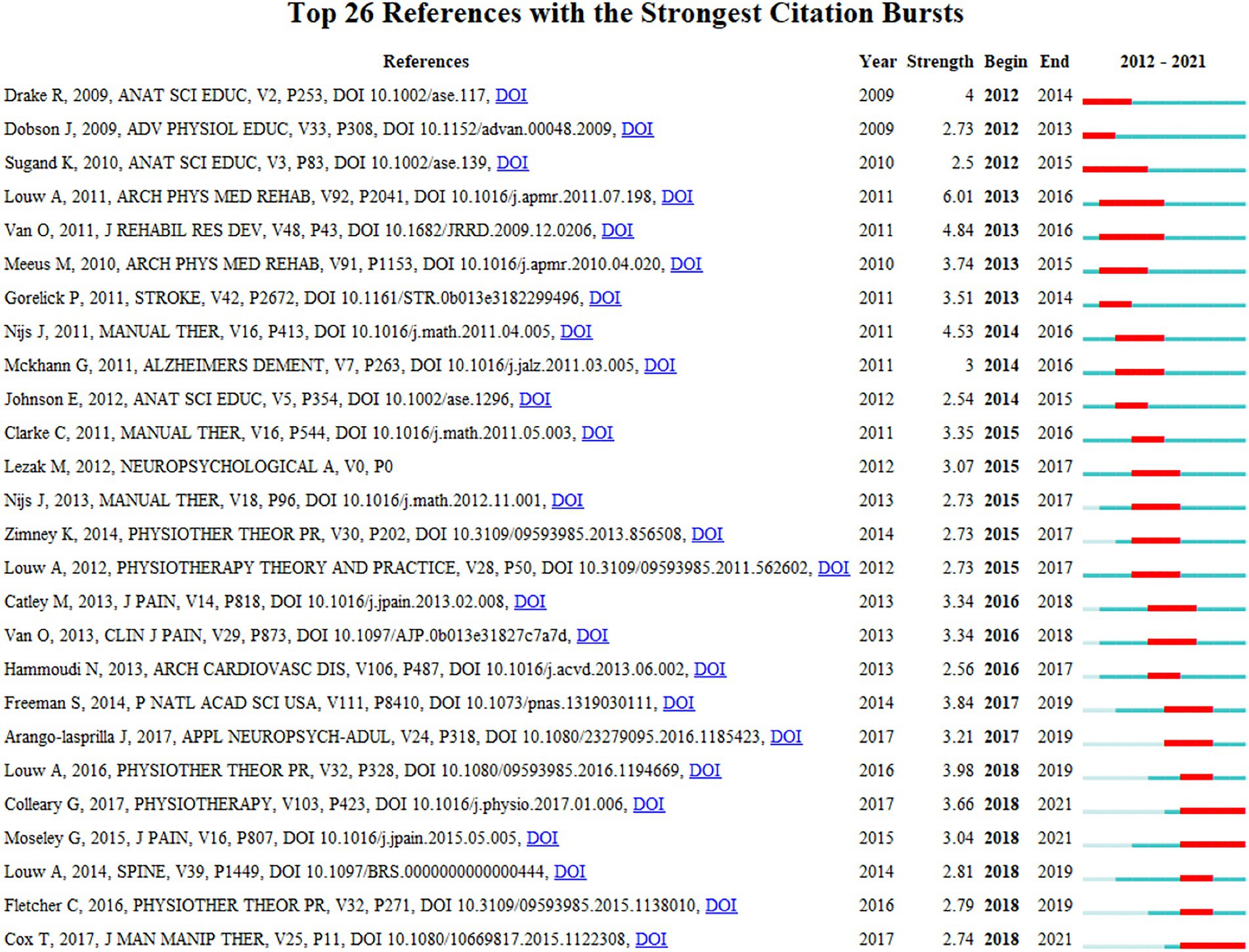
Figure 10. Top 26 references with the strongest citation bursts (sorted by the beginning year of burst). The blue bars mean the reference had been published; the red bars mean citation burstness.
Discussion
Based on the data from WoSCC database, this study performed a bibliometric analysis of 2,882 PTR-related publications published in 466 academic journals by 13,895 authors in 4072 organizations from 67 countries/regions. Change in annual output is an essential indicator of development in a field. PTR-related articles displayed an annual overall upward tendency with some fluctuations each year from 2012 to 2021. The change does not reflect a clear phasing, but rather a continuous and steady trend of growth. Thus, it is expected that exploration of physiology teaching research will continue to be of interest for long into the future.
Contribution analysis of authors with many co-occurrences or co-cited papers in a specific field is helpful for sorting out key information such as research background and author collaborations. Focusing on co-authors and co-cited authors, we found that 70 authors published more than five articles from 13,895 authors in PTR. Arango-Lasprilla. and Rivera. both published the most papers, while Moseley had the most co-citations at more than 300. These findings imply that an author’s article has a high impact or is a landmark paper in that field during that time period. These results deserve further exploration. Furthermore, the map of authors and co-cited authors provides information about potential collaborators and influential research groups. In the PTR field, researchers actively cooperate within and between institutions. Besides the influence of the authors themselves, the research institutions are an important influencing factor in contributions to a research field. For example, 328 organizations published more than five articles from 4,072 organizations. The University of California published the most papers, which reflects the high importance that the United States attaches to medical education. From a national perspective, the United States, England, Australia, Canada, Spain, and China were the top six productive countries. It is worth noting that the United States was the first and dominant country taking up PTR research in the time frame studied. Largely due to language limitations in database inclusion and screening criteria, the volume of publications from China is slightly lower.
The journals and co-cited journals analysis presented that Advances in Physiology Education published the most papers. Critical Care Medicine was in the Q1 JCR division. Anatomical Sciences Education and Critical Care Medicine each have an impact factor greater than 5. These findings highlight the strong influence and guiding role that these journals play in PTR field. Advances in Physiology Education had the most co-citations, Critical Care Medicine was second and has an IF of 7.598 (2020) in the JCR Q1 division, and Clinical Neurophysiology is third for co-citations. The Cochrane Database of Systematic Reviews has the highest IF among the top 10 co-cited journals at 9.266, and thus plays a leading role in the field. Both of these journals are in the Psychology, Education, and Medicine category, which is consistent with the dual-map analysis. The dual-map overlay of journals indicates their topic distribution. The three primary citation paths from Psychology/Education/Social journals, Health/Nursing/Medicine journals, and Molecular/Biology/Genetics journals were mainly cited by studies published in Medicine/Medical/Clinical journals. The three primary citation paths from Molecular/Biology/Genetics journals, Health/Nursing/Medicine journals, and Psychology/ Education/Social journals were mainly cited by studies published in Psychology/Education/Health journals. The one primary citation path from Psychology/Education/Social journals was mainly cited by studies published in Neurology/Sports/Ophthalmology journals. These findings imply that physiological research is focused on basic research, is closely integrated with clinical research, and is gradually integrating the importance of healthy lifestyle; however, research on translational medicine is still limited. Journals in the Q1 JCR division with a high IF accounted for most of the top 10 journals (10%) and co-cited journals (40%). These findings indicate that these journals are interested in and play essential roles in physiological-related research, and thus have greater development space. Notably, Louw et al. published the first co-cited reference, which was on the effectiveness of neuroscience education for pain, disability, anxiety, and stress in chronic musculoskeletal pain. This was also the reference with the strongest citation burstness from 2013 to 2016 published in Arch Phys Med Rehabil. This shows that of PTR research is inseparable from basic research and on-going development of basic research is still an important link to teaching reform.
Examining co-occurrence and cluster analysis of keywords can help guide the evolution process and clarify research directions. We analyzed the trajectories, frequency, and centrality of the keyword network. “Education” had a high frequency and centrality, while the terms “Alzheimer’s disease” and “performance” were high frequency keywords, reflecting that physiological research about Alzheimer’s disease is currently a hot topic. Furthermore, it shows that the “BRAIN Initiative” announced by the National Institutes of Health (NIH) (37), which is cognitive impairment-oriented program combined with clinical research and teaching reform, is closely linked and thus a good starting point for reform. Physiology relevant research is still a research hotspot and the overall trend is increasing year by year. According to the link strength of term co-occurrence, the network was divided into 11 clusters with high homogeneity and salient connections. Rehabilitation (Cluster 1), Neurosciences (Cluster 2), and Infectious Disease (Cluster 3) remain an important part of PTR. With mental and neurological health becoming the focus of attention in recent years, clinical neuropsychology may be positioned to take a new turn and grow at a rapid pace.
From our analysis, we can see that research on PTR initially focused on the education method itself. Afterward, basic research in the fields of rehabilitation, neuroscience, and infectious diseases gradually deepened, such as Alzheimer’s disease, Parkinson’s disease, and pain. Notably, a healthy lifestyle supported by clinical guidance has gradually become a hot topic. We are in an important development stage of medicine as research moves toward supporting people’s health. However, in depth basic physiological research is still necessary, which is consistent with the findings of our bibliometric analysis.
Compared with other reviews, our study using CiteSpace provided a visualization of research hotspots and frontiers. However, this study suffers from certain limitations inherent to bibliometrics. Firstly, data were retrieved only from the WoSCC database, and studies not included in the WoSCC may have been missed. Furthermore, for this paper, only articles published in English were included. The large number of articles published in Chinese in the China national knowledge infrastructure (CNKI) database is still a significant reference with comparative research value. Secondly, differences in screening strategies may lead to slightly different results. Nevertheless, we believe that the use of multiple bibliometric tools and quantitative analysis support the reliability of this study, which can provide researchers with a richer source of objective information.
Conclusion
In summary, research in PTR is experiencing a rapid phase of development with active global collaborations with the United States as the center within the current search scope. Current publications are focused on medicine, education, and neurology. Rehabilitation, neuroscience, and infectious diseases are popular research areas within physiology research. In particular, research into the pathogenesis, treatment strategies, and technological updates of neurological disorders is becoming a hot topic. We also analyzed the data using CiteSpace and VosViewer, which allow for richer results from different perspectives. Compared to traditional reviews, this study provides original and objective insights into research on PTR. We believe that the results of this study will be a useful reference in the future.
Data availability statement
The raw data supporting the conclusions of this article will be made available by the authors, without undue reservation.
Author contributions
JX and QM designed this study, performed the analysis, and normalized the pictures. SS and YZ collected the data. JX wrote the original draft. All authors contributed to the article and approved the submitted version.
Funding
This work was supported by the Higher Education Research Project of Zhejiang Higher Education Society (KT2021067), the Teaching and Research Project of Ningbo University (JYXMXZD2021030), the Ningbo Education Science Planning Project (2021YGH009), and the Fundamental Research Funds for the Provincial Universities of Zhejiang (SJLZ2022001).
Acknowledgments
The authors would like to thank Ningbo University, Zhejiang Higher Education Society, Ningbo Education Science Planning Project, and the Provincial Universities of Zhejiang Project for supporting that work.
Conflict of interest
The authors declare that the research was conducted in the absence of any commercial or financial relationships that could be construed as a potential conflict of interest.
Publisher’s note
All claims expressed in this article are solely those of the authors and do not necessarily represent those of their affiliated organizations, or those of the publisher, the editors and the reviewers. Any product that may be evaluated in this article, or claim that may be made by its manufacturer, is not guaranteed or endorsed by the publisher.
Supplementary material
The Supplementary material for this article can be found online at: https://www.frontiersin.org/articles/10.3389/fmed.2023.1031713/full#supplementary-material
Footnotes
References
1. Sengupta, J, and Barman, SM. Global status of physiology in research, education, and outreach. Physiology (Bethesda). (2018) 33:7–9. doi: 10.1152/physiol.00027.2017
2. Wehrwein, EA. Setting national guidelines for physiology undergraduate degree programs. Adv Physiol Educ. (2018) 42:1–4. doi: 10.1152/advan.00051.2017
3. Logan, DW. Hot to touch: the story of the 2021 Nobel prize in physiology or medicine. Dis Model Mech. (2021) 14:049352. doi: 10.1242/dmm.049352
4. Meanwell, NA, Georg, GI, and Wang, S. The 2020 Nobel prize in physiology or medicine. J Med Chem. (2020) 63:13197–204. doi: 10.1021/acs.jmedchem.0c01877
5. Noble, D. The Nobel prize for medicine and physiology, 2019. Prog Biophys Mol Biol. (2019) 148:1. doi: 10.1016/j.pbiomolbio.2019.10.005
6. VanRyn, VS, Poteracki, JM, and Wehrwein, EA. Physiology undergraduate degree requirements in the U.S. Adv Physiol Educ. (2017) 41:572–7. doi: 10.1152/advan.00104.2016
7. Henriksen, EJ. Undergraduate physiology degree programs in the United States: from famine to feast. Physiology (Bethesda). (2015) 30:254–5. doi: 10.1152/physiol.00015.2015
8. Li, YY, Li, K, Yao, H, Xu, XJ, and Cai, QL. Reform in teaching preclinical pathophysiology. Adv Physiol Educ. (2015) 39:254–8. doi: 10.1152/advan.00165.2014
9. Emery, N, Maher, JM, and Ebert-May, D. Environmental influences and individual characteristics that affect learner-centered teaching practices. PLoS One. (2021) 16:e0250760. doi: 10.1371/journal.pone.0250760
10. Semsar, K, Brownell, S, Couch, BA, Crowe, AJ, Smith, MK, Summers, MM, et al. Phys-MAPS: a programmatic physiology assessment for introductory and advanced undergraduates. Adv Physiol Educ. (2019) 43:15–27. doi: 10.1152/advan.00128.2018
11. Sherer, R, Wan, Y, Dong, H, Cooper, B, Morgan, I, Peng, B, et al. Positive impact of integrating histology and physiology teaching at a medical school in China. Adv Physiol Educ. (2014) 38:330–8. doi: 10.1152/advan.00071.2014
12. Ma, D, Yang, B, Guan, B, Song, L, Liu, Q, Fan, Y, et al. A bibliometric analysis of pyroptosis from 2001 to 2021. Front Immunol. (2021) 12:731933. doi: 10.3389/fimmu.2021.731933
13. Wang, YQ, Chen, YB, Xu, D, and Cui, YL. Bibliometrics and visualization of the mechanisms of Parkinson's diseases based on animal models. Endocr Metab Immune Disord Drug Targets. (2020) 20:1560–8. doi: 10.2174/1871530320666200421103429
14. Wang, Y, Zhao, N, Zhang, X, Li, Z, Liang, Z, Yang, J, et al. Bibliometrics analysis of Butyrophilins as immune regulators [1992-2019] and implications for cancer prognosis. Front Immunol. (2020) 11:1187. doi: 10.3389/fimmu.2020.01187
15. Chen, C. Predictive effects of structural variation on citation counts. J. Assoc. Inf. Sci. Technol. (2012) 63:431–49. doi: 10.1002/asi.21694
16. Cobo, MJ, López-Herrera, AG, Herrera-Viedma, E, and Herrera, F. Science mapping software tools: review, analysis, and cooperative study among tools. J Assoc Inf Sci Technol. (2011) 62:1382–402. doi: 10.1002/asi.21525
17. Chen, C, Dubin, R, and Kim, MC. Emerging trends and new developments in regenerative medicine: a scientometric update (2000–2014). Expert Opin Biol Ther. (2014) 14:1295–317. doi: 10.1517/14712598.2014.920813
18. Chen, C, and Leydesdorff, L. Patterns of connections and movements in dual-map overlays: A new method of publication portfolio analysis. J Assoc Inf Sci Technol. (2014) 65:334–51. doi: 10.1002/asi.22968
19. van Eck, NJ, and Waltman, L. Software survey: VOSviewer, a computer program for bibliometric mapping. Scientometrics. (2010) 84:523–38. doi: 10.1007/s11192-009-0146-3
20. Chen, C. Searching for intellectual turning points: progressive knowledge domain visualization. Proc Natl Acad Sci U S A. (2004) 101:5303–10. doi: 10.1073/pnas.0307513100
21. Zhang, J, Song, L, Xu, L, Fan, Y, Wang, T, Tian, W, et al. Knowledge domain and emerging trends in ferroptosis research: a bibliometric and knowledge-map analysis. Front Oncol. (2021) 11:686726. doi: 10.3389/fonc.2021.686726
22. Chen, C. CiteSpace II: detecting and visualizing emerging trends and transient patterns in scientific literature. J. Am. Soc. Inf. Sci. (2006) 57:359–77. doi: 10.1002/asi.20317
23. Van Eck, NJ, and Waltman, L. VOSviewer Manual: Manual for VOSviewer Version 1.6. 15. Leiden: Centre for Science and Technology Studies (CWTS) of Leiden University (2020).
24. Carrión-Mero, P, Montalván-Burbano, N, Morante-Carballo, F, Quesada-Román, A, and Apolo-Masache, B. Worldwide research trends in landslide science. Int J Environ Res Public Health. (2021) 18:9445. doi: 10.3390/ijerph18189445
25. Ke, L, Lu, C, Shen, R, Lu, T, Ma, B, and Hua, Y. Knowledge mapping of drug-induced liver injury: a scientometric investigation (2010–2019). Front Pharmacol. (2020) 11:842. doi: 10.3389/fphar.2020.00842
26. Qin, Y, Zhang, Q, and Liu, Y. Analysis of knowledge bases and research focuses of cerebral ischemia-reperfusion from the perspective of mapping knowledge domain. Brain Res Bull. (2020) 156:15–24. doi: 10.1016/j.brainresbull.2019.12.004
27. Louw, A, Diener, I, Butler, DS, and Puentedura, EJ. The effect of neuroscience education on pain, disability, anxiety, and stress in chronic musculoskeletal pain. Arch Phys Med Rehabil. (2011) 92:2041–56. doi: 10.1016/j.apmr.2011.07.198
28. Moseley, GL, and Butler, DS. Fifteen years of explaining pain: The past, present, and future. J Pain. (2015) 16:807–13. doi: 10.1016/j.jpain.2015.05.005
29. Freeman, S, Eddy, SL, McDonough, M, Smith, MK, Okoroafor, N, Jordt, H, et al. Active learning increases student performance in science, engineering, and mathematics. Proc Natl Acad Sci U S A. (2014) 111:8410–5. doi: 10.1073/pnas.1319030111
30. Van Oosterwijck, J, Nijs, J, Meeus, M, Truijen, S, Craps, J, Van den Keybus, N, et al. Pain neurophysiology education improves cognitions, pain thresholds, and movement performance in people with chronic whiplash: a pilot study. J Rehabil Res Dev. (2011) 48:43–58. doi: 10.1682/jrrd.2009.12.0206
31. Louw, A, Diener, I, Landers, MR, and Puentedura, EJ. Preoperative pain neuroscience education for lumbar radiculopathy: a multicenter randomized controlled trial with 1-year follow-up. Spine (Phila Pa 1976). (2014) 39:1449–57. doi: 10.1097/brs.0000000000000444
32. Louw, A, Puentedura, EL, and Zimney, K. Teaching patients about pain: it works, but what should we call it? Physiother Theory Pract. (2016) 32:328–31. doi: 10.1080/09593985.2016.1194669
33. Arango-Lasprilla, JC, Stevens, L, Morlett Paredes, A, Ardila, A, and Rivera, D. Profession of neuropsychology in Latin America. Appl Neuropsychol Adult. (2017) 24:318–30. doi: 10.1080/23279095.2016.1185423
34. Nijs, J, Paul van Wilgen, C, Van Oosterwijck, J, van Ittersum, M, and Meeus, M. How to explain central sensitization to patients with 'unexplained' chronic musculoskeletal pain: practice guidelines. Man Ther. (2011) 16:413–8. doi: 10.1016/j.math.2011.04.005
35. Colleary, G, O'Sullivan, K, Griffin, D, Ryan, CG, and Martin, DJ. Effect of pain neurophysiology education on physiotherapy students' understanding of chronic pain, clinical recommendations and attitudes towards people with chronic pain: a randomised controlled trial. Physiotherapy. (2017) 103:423–9. doi: 10.1016/j.physio.2017.01.006
36. Olabarrieta-Landa, L, Caracuel, A, Pérez-García, M, Panyavin, I, Morlett-Paredes, A, and Arango-Lasprilla, JC. The profession of neuropsychology in Spain: results of a national survey. Clin Neuropsychol. (2016) 30:1335–55. doi: 10.1080/13854046.2016.1183049
Keywords: bibliometrics, knowledge-map, physiology, teaching reform, visualization
Citation: Xu J, Sun S, Zhao Y and Ma Q (2023) Knowledge domain, research hotspots and frontiers in physiology teaching reforms from 2012 to 2021: A bibliometric and knowledge-map analysis. Front. Med. 10:1031713. doi: 10.3389/fmed.2023.1031713
Edited by:
Amberly Reynolds, Rocky Vista University, United StatesReviewed by:
Renuka Sharma, Vardhman Mahavir Medical College & Safdarjung Hospital, IndiaNatasa Popovic, University of Montenegro, Montenegro
Irina Nizamutdinova, University of the Incarnate Word School of Osteopathic Medicine, United States
Copyright © 2023 Xu, Sun, Zhao and Ma. This is an open-access article distributed under the terms of the Creative Commons Attribution License (CC BY). The use, distribution or reproduction in other forums is permitted, provided the original author(s) and the copyright owner(s) are credited and that the original publication in this journal is cited, in accordance with accepted academic practice. No use, distribution or reproduction is permitted which does not comply with these terms.
*Correspondence: Jia Xu, eHVqaWFAbmJ1LmVkdS5jbg==
 Jia Xu
Jia Xu Shimeng Sun
Shimeng Sun Yadong Zhao
Yadong Zhao Qing Ma
Qing Ma